|

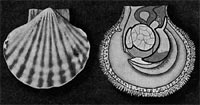 Open, close, go! Scallops may be attached to a substrate by a structure called a byssus. They can also be free living. A scallop can swim by rapidly
opening and closing its shell. This method of rapidly opening and
closing its shell is also a defense technique, protecting it from
any threats. Open, close, go! Scallops may be attached to a substrate by a structure called a byssus. They can also be free living. A scallop can swim by rapidly
opening and closing its shell. This method of rapidly opening and
closing its shell is also a defense technique, protecting it from
any threats.
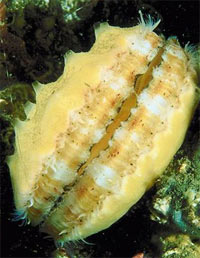 Switching sexes: Scallops are hermaphidic (ie, capible of switching sexes), and
both sexes produce roe with distinct coloring depending upon the
current sex. Red roe is that of a female and white that of a male.
Spermatazoa and ova are released freely into the water during mating
season and fertilized ova sink to the bottom. After several weeks,
the immature scallop hatches and the larvae drift until settling
to the bottom again to grow. They reach sexual maturity after several
years, though they may not reach a commercially harvestable size
until 6 to 8 years of age. Scallop may live to be as old as 18 years
of age, this being reflected in the annuli, the concentric rings
of their shells. Scallops migrate in large schools through out the
year. Switching sexes: Scallops are hermaphidic (ie, capible of switching sexes), and
both sexes produce roe with distinct coloring depending upon the
current sex. Red roe is that of a female and white that of a male.
Spermatazoa and ova are released freely into the water during mating
season and fertilized ova sink to the bottom. After several weeks,
the immature scallop hatches and the larvae drift until settling
to the bottom again to grow. They reach sexual maturity after several
years, though they may not reach a commercially harvestable size
until 6 to 8 years of age. Scallop may live to be as old as 18 years
of age, this being reflected in the annuli, the concentric rings
of their shells. Scallops migrate in large schools through out the
year.

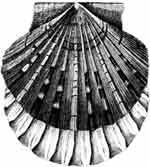 The shell of Saint James : The scallop shell is the traditional emblem of Saint James the Great and is popular with pilgrims on the Way of St James to the apostles shrine at Santiago de Compostela in Spain. Medieval Christians making the pilgrimage to his shrine often wore a scallop shell symbol on their hats or clothes. The pilgrim also carried a scallop shell with him and would present himself at churches, castles, abbeys etc. where he could expect to be given as much sustenance as he could pick up with one scoop. Probably he would be given oats, barley perhaps beer or wine. Thus even the poorest household could give charity without being overburdened. The association of Saint James with the scallop can most likely be traced to the legend that the apostle once rescued a knight covered in scallops. An alternate version of the legend holds that while St. James's remains were being transported to Spain from Jerusalem, the horse of a knight fell into the water, and emerged covered in the shells. The shell of Saint James : The scallop shell is the traditional emblem of Saint James the Great and is popular with pilgrims on the Way of St James to the apostles shrine at Santiago de Compostela in Spain. Medieval Christians making the pilgrimage to his shrine often wore a scallop shell symbol on their hats or clothes. The pilgrim also carried a scallop shell with him and would present himself at churches, castles, abbeys etc. where he could expect to be given as much sustenance as he could pick up with one scoop. Probably he would be given oats, barley perhaps beer or wine. Thus even the poorest household could give charity without being overburdened. The association of Saint James with the scallop can most likely be traced to the legend that the apostle once rescued a knight covered in scallops. An alternate version of the legend holds that while St. James's remains were being transported to Spain from Jerusalem, the horse of a knight fell into the water, and emerged covered in the shells.
* The Swedish word for scallop literally translates to pilgrim mussel.
* A French name for a dish containing scallops is coquille St. Jacques (in Québec, pétoncle is more commonly used).
* The Dutch name is Jakobsschelp (Jakob being Dutch for James).
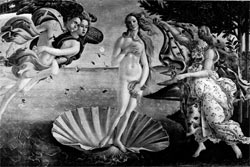 Scallop of love and fertility: Many paintings of Venus, the Roman goddess of love and fertility, included a scallop shell in the painting to identify her; this is evident in Botticelli's classically inspired The Birth of Venus (which has even been nicknamed "Venus on the half-shell"). Scallop of love and fertility: Many paintings of Venus, the Roman goddess of love and fertility, included a scallop shell in the painting to identify her; this is evident in Botticelli's classically inspired The Birth of Venus (which has even been nicknamed "Venus on the half-shell").
Setting sun scallop: Alternatively, the scallop resembles the Setting Sun, which was the focus of the pre-Christian Celtic rituals of the area. To wit, the pre-Christian roots of the Way of St. James was a Celtic death journey westwards towards the setting sun, terminating at the End of the World (Finisterra) on the "Coast of Death" (Costa de Morta) and the "Sea of Darkness" (ie, the Abyss of Death, the Mare Tenebrosum, Latin for the Atlantic Ocean, itself named after the Dying Civilization of Atlantis). The reference to St. James rescuing a "knight covered in scallops" is therefore a reference to St. James healing, or resurrecting, a dying (setting sun) knight. Similarly, the notion of the "Sea of Darkness" (Atlantic Ocean) disgorging St. James' body, so that his relics are (allegedly) buried at Santiago de Compostella on the coast, is itself a metaphor for "rising up out of Death", that is, resurrection.[citation needed]
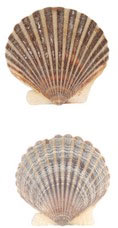 Heraldry: The scallop shell symbol found its way into heraldry as a badge of those who had been on the pilgrimage to Compostela, although later it became a symbol of pilgrimage in general. Winston Churchill's family coat of arms includes a scallop, as does John Wesley's (and as a result the scallop shell is used as an emblem of Methodism). However, charges in heraldry do not always have an unvarying symbolic meaning, and there are cases of arms in which no family member went on a pilgrimage and the occurrence of the scallop is simply a pun on the name of the armiger, or for other reasons. Heraldry: The scallop shell symbol found its way into heraldry as a badge of those who had been on the pilgrimage to Compostela, although later it became a symbol of pilgrimage in general. Winston Churchill's family coat of arms includes a scallop, as does John Wesley's (and as a result the scallop shell is used as an emblem of Methodism). However, charges in heraldry do not always have an unvarying symbolic meaning, and there are cases of arms in which no family member went on a pilgrimage and the occurrence of the scallop is simply a pun on the name of the armiger, or for other reasons.
Oil shell: The multinational oil company Royal Dutch Shell uses a red and yellow scallop shell emblem as its logo.
NY state shell: The U.S. state of New York made the bay scallop its state shell in 1988.
All text is available under the terms
of the GNU Free Documentation License
|